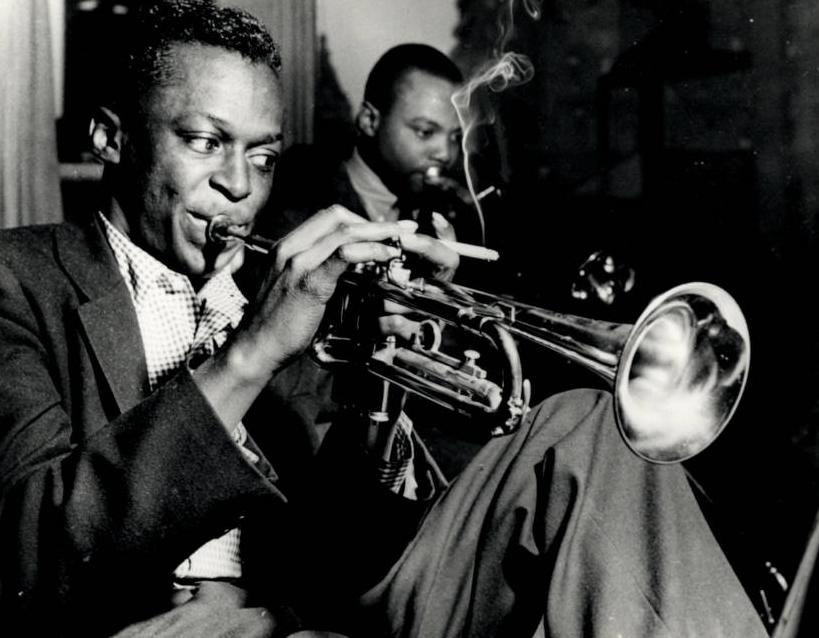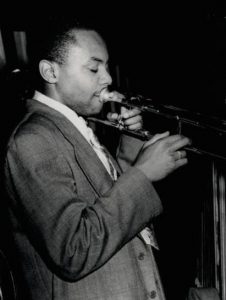(Jan. 22, 1924 -Feb. 4, 2001). James Louis (J. J.) Johnson entered the world of music at nine years old. His mother, Nina Johnson, was adamant that her children learn to play music and hired a piano teacher to provide lessons. Johnson quickly took to playing music, developing a passion for it.

When he entered high school in 1937 at , he focused on music and English. Having fallen in love with jazz, he switched to the trombone after a brief and unproductive stint with a baritone saxophone. After school, Johnson and his friends would sneak into clubs on to listen and even occasionally play. His first formal engagement was at Sunset Terrace Club with the Clarence Love Orchestra, a Kansas City ensemble led by saxophonist and bandleader Clarence Love.
Johnson began his professional career right out of high school when he started touring with Clarence Love in 1941 and then later with jazz pianist and bandleader Snookum Russell in 1942. At the end of 1942, Johnson had the opportunity to play fill-in for a trombonist in jazz saxophonist and clarinetist Benny Carter’s orchestra at the Sunset Terrace. Carter was impressed with the 18-year-old’s skills and offered him a long-term gig that lasted until 1945.
After this, Johnson spent a year touring and recording with legendary jazz musician William (Count) Basie’s band.
By 1946 Johnson was playing in various small bands in New York City clubs. Arrested for drug possession, he lost his NYC Cabaret Card (a required permit that Johnson would later help to abolish) and access to regular work. Despite this, Johnson managed to occasionally play with such musicians as tenor saxophonist Illinois Jacquet, who has been credited with making the instrument a regular feature of jazz music. He also played with much-sought-after bassist virtuoso Oscar Pettiford and trumpeter Howard McGhee in military camps in Japan and Korea in 1951.
Between the struggle in getting his Cabaret Card reinstated and his desire to distance himself from drug use, Johnson took a break from the jazz scene. In 1952, he began a day job as a blueprint inspector at Sperry Gyroscope Company. He maintained this role for two years before getting back to jazz full time.
In 1954, the Savoy record label approached Johnson and trombonist Kai Winding about recording music with two trombones as lead instruments. The two musicians consented, co-leading the Jay and Kai Quintet. They were a huge success both musically and commercially. The band recorded several albums and toured across the United States during the two years they were together. Even though the band parted ways in 1956, they reunited a few times over the next couple of decades for performances and recordings.
From the mid-1950s through the 1960s, Johnson dedicated more time to composing music. His first large-scale composition was “Poem for Brass” on Columbia’s Music for Brass record in 1956. He quickly gained recognition as a composer and was commissioned for more work, including “El Camino Real” and “Sketch for Trombone and Orchestra,” (both 1959) as well as “Perceptions,” in 1961 with jazz trumpet great Dizzy Gillespie. In 1963, Johnson featured his composition and arranging talents through his solo album J. J.’s Broadway. Johnson was kept busy throughout 1965 recording several group studio albums that featured many of his original compositions and arrangements. That year, he also spent time in Vienna recording his Euro Suite album.
By the 1970s, Johnson had left New York for California and began working on television and film scores. His work was featured in television programs like Mod Squad (ABC, 1968-1973) and Six Million Dollar Man (ABC, 1973-1978) and in films like Scarface (1983) and Sea of Love (1989). While he only performed live a few times during this decade, he did record several albums as both a leader and sideman.
Johnson moved across the country again in the late 1980s, this time returning to Indianapolis. In 1988, Johnson toured the United States, Europe, and Japan. He also performed at the iconic New York City jazz club Village Vanguard in July 1988, where the Quintergy and Standards albums were recorded live. This same year, Johnson’s wife Vivian suffered a debilitating stroke. He put jazz on pause to spend the next few years caring for Vivian until she died.
Johnson stepped back into the jazz spotlight for a brief period starting in 1992. He spent the next several years performing and recording new albums under a contract with Verve including Tangence (1995), The Brass Orchestra (1996), and Heroes (1998). Ready for retirement from performing, Johnson gave his last concert at William Paterson College in Wayne, New Jersey, in November 1996.
Known as a trombonist who redefined what it was to play the trombone, Johnson’s impressive career spanned over 50 years. He left a legacy in the jazz world through his skillful use of the slide trombone in bebop-style jazz and his hit compositions and arrangements.
In recognition of his achievements, Johnson received several awards and honors including multiple Grammy nominations, the Indiana Governor’s Art Award (1989), an honorary doctoral degree from Indiana University, and “Trombonist of the Year” in magazine. In 1995, he was voted into the Down Beat Hall of Fame. At the end of his career in 1996, he received the American Jazz Masters fellowship from the National Endowment of the Arts.

Help improve this entry
Contribute information, offer corrections, suggest images.
You can also recommend new entries related to this topic.





